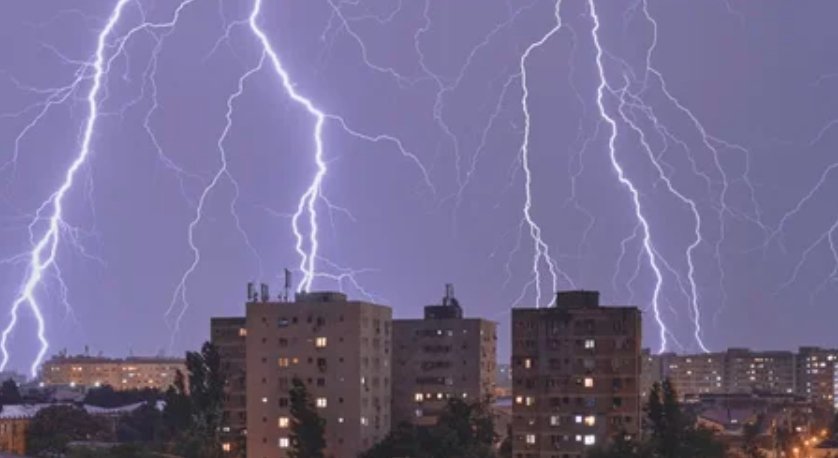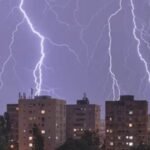A yellow weather warning has been slapped on much of Scotland, with heavy thunderstorms and downpours expected to cause chaos across cities, roads, and rural areas. The Met Office issued the alert on Friday, citing a risk of flash flooding, lightning strikes, and possible transport disruption.
This latest turn in the weather comes as Scotland has experienced an unusually unstable June, leaving locals and tourists on edge as unpredictable skies threaten summer plans. With cities like Edinburgh, Glasgow, and Dundee in the warning zone, councils and emergency services are now on high alert.
Met Office Issues Thunderstorm Alert Across Central and Eastern Scotland
The yellow warning stretches across a broad swathe of the country, with the Met Office flagging potential storm activity for a 12-hour window starting from noon on Friday. The warning covers:
-
Edinburgh
-
Glasgow
-
The Lothians
-
Dundee
-
Parts of central, eastern, and southern Scotland
Forecasters warned of slow-moving thunderstorms that could bring up to 30mm of rain in just an hour, with isolated spots seeing even more.
Some areas could face brief power cuts.
Lightning, hail, and poor visibility could combine to create a tricky situation for drivers and commuters. The warning currently runs until midnight, though updates may follow depending on storm development.

Flooding Risk Triggers Preparedness Measures in Local Councils
In Edinburgh, city officials said gully-clearing teams were already deployed early Friday morning. “We’re closely monitoring drainage systems,” one spokesperson told local media, “especially in low-lying areas prone to flash floods.”
Meanwhile in Glasgow, sandbags were seen stacked in vulnerable residential spots in the Southside and West End.
One resident near the River Kelvin said, “Every time there’s a warning like this, we don’t sleep properly. A few summers ago, the water nearly reached our back door.”
That anxiety is growing outside urban zones too. Farmers in Angus and the Borders are worried about saturated soil and washed-out fields. And across the Highlands, where roads are narrow and cell signals patchy, even a short burst of rain can mean isolation.
Weekend Events at Risk as Outdoor Plans Get Rained Off
From music festivals to Highland games, Scotland’s packed summer calendar now faces interruptions.
In Edinburgh, concerns swirled around the popular Meadows Festival, with organisers saying they’ll decide by Saturday morning whether to go ahead or postpone.
Elsewhere, Glasgow’s Queen’s Park and Kelvingrove are expected to cancel community sports and children’s activities if the storms persist through Saturday afternoon.
Short sentence here.
A few tourists visiting Loch Lomond said they were considering cutting their trip short.
How the Warning Compares: Scotland’s Recent Storm Trends
If it feels like these warnings are getting more frequent, you’re not imagining it. According to Met Office data from 2024, Scotland saw a 19% increase in yellow thunderstorm warnings compared to the five-year average.
Here’s a quick snapshot of how this year stacks up:
| Year | Yellow Storm Warnings | Average Monthly Rainfall (mm) | Significant Flooding Events |
|---|---|---|---|
| 2021 | 12 | 78.4 | 3 |
| 2022 | 15 | 83.1 | 4 |
| 2023 | 17 | 87.5 | 5 |
| 2024 | 21 | 91.2 | 6 |
| 2025 (YTD) | 14 (till June) | 94.6 | 4 |
That spike in rainfall has mirrored an uptick in flash floods, leaving communities from Aberdeenshire to Ayrshire scrambling to adapt. Urban drainage systems are now under constant pressure.
Drivers, Commuters, and Rail Users Told to Expect Delays
Transport Scotland urged caution for drivers and rail users, especially during Friday’s evening rush. The A9, M8, and M90 corridors are considered high-risk routes for surface water and sudden braking incidents.
Trains may also be delayed if lightning hits signal equipment or if floodwater reaches track level. ScotRail has already issued a “check before you travel” advisory on its social platforms.
Even short journeys might take longer today.
Bullet point from Transport Scotland’s advisory includes:
-
Reduce speed in heavy rain or low visibility
-
Avoid driving through standing water
-
Check wiper blades and tyres before setting off
-
Allow extra time for travel
One ScotRail employee based at Waverley Station added, “We’re bracing for delays, especially between Edinburgh and Perth. If water levels rise, we’ll have to slow down or stop trains entirely.”
Local Voices: “It’s Becoming the New Normal”
Scotland’s changing weather patterns are hard to ignore. Locals say it’s not just the odd storm anymore — it feels like these sudden downpours are the rule, not the exception.
Maureen Johnston, a shopkeeper in Stirling, has seen it all. “We used to worry about snow,” she laughs. “Now it’s water everywhere. You can go out in the morning with sunglasses and come back drenched before lunch.”
In Dumfries, school officials reported internal flooding in a primary school’s basement during a similar storm last month. Repairs are still ongoing.
And in Perthshire, a couple who lost part of their garden to riverbank erosion last summer say they’re investing in extra flood barriers. “It’s a bit mad, really. You live in the countryside for peace and quiet, and now you’re constantly checking the forecast,” the husband told us.
Even the Scottish Fire and Rescue Service is adjusting — with new training modules and water rescue drills becoming a regular part of operations in wetter months.


















